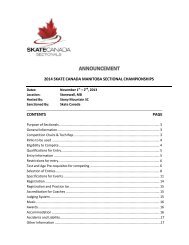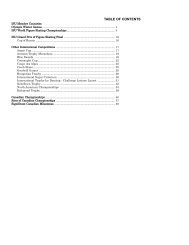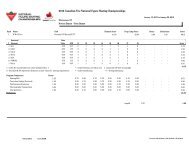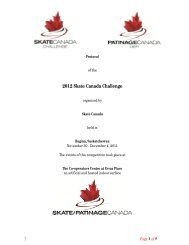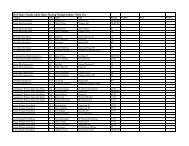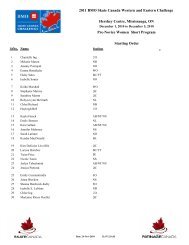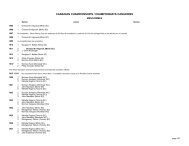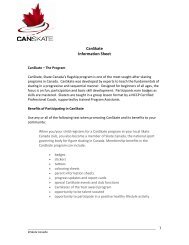LONG-TERM ATHLETE DEVELOPMENT - Skate Canada
LONG-TERM ATHLETE DEVELOPMENT - Skate Canada
LONG-TERM ATHLETE DEVELOPMENT - Skate Canada
Create successful ePaper yourself
Turn your PDF publications into a flip-book with our unique Google optimized e-Paper software.
G L O S S A R Y O F T E R M S<br />
L o n g - Te r m A t h l e t e D e v e l o p m e n t<br />
73<br />
A P P E N D I X A<br />
865 Sheord Road, Ottawa, Ontario K1J 1H9<br />
Adaptation refers to a response to a stimulus Phone 613.747.1007 or a series I of Toll stimuli Free 1.888.747.2372 that induces I Fax functional 613.748.5718 and/or I Toll Free morphological<br />
Fax 1.877.211.2372<br />
changes in the organism. Naturally, the level or degree of adaptation is dependent upon the genetical endowment<br />
of an individual. However, the general trends or patterns of adaptation are identified by physiological research, and<br />
guidelines are clearly delineated of the various adaptation processes, such as adaptation to muscular endurance or<br />
maximum strength.<br />
Adolescence is a difficult period to define in terms of the time of its onset and termination. During this period, most<br />
bodily systems become adult both structurally and functionally. Structurally, adolescence begins with an acceleration<br />
in the rate of growth in stature, which marks the onset of the adolescent growth spurt. The rate of statural growth<br />
reaches a peak, begins a slower or decelerative phase, and finally terminates with the attainment of adult stature.<br />
Functionally, adolescence is usually viewed in terms of sexual maturation, which begins with changes in the<br />
neuroendocrine system prior to overt physical changes and terminates with the attainment of mature reproductive<br />
function.<br />
Ancillary Capacities refer to the knowledge and experience base of an athlete and includes warm-up and cool-down<br />
procedures, stretching, nutrition, hydration, rest, recovery, restoration, regeneration, mental preparation, and taper<br />
and peak. The more knowledgeable athletes are about these training and performance factors, the more they can<br />
enhance their training and performance levels. When athletes reach their genetic potential and physiologically cannot<br />
improve anymore, performance can be improved by using the ancillary capacities to full advantage.<br />
Childhood ordinarily spans the end of infancy — the first birthday — to the start of adolescence and is characterized by<br />
relatively steady progress in growth and maturation and rapid progress in neuromuscular or motor development. It is<br />
often divided into early childhood, which includes pre-school children aged one to five years, and late childhood, which<br />
includes elementary school-age children, aged six through to the onset of adolescence.<br />
Chronological age refers to the number of years and days elapsed since birth. Growth, development, and maturation<br />
operate in a time framework; that is, the child’s chronological age. Children of the same chronological age can differ<br />
by several years in their level of biological maturation. The integrated nature of growth and maturation is achieved by<br />
the interaction of genes, hormones, nutrients, and the physical and psychosocial environments in which the individual<br />
lives. This complex interaction regulates the child’s growth, neuromuscular maturation, sexual maturation, and general<br />
physical metamorphosis during the first two decades of life.<br />
Critical periods of development refers to a point in the development of a specific behaviour when experience or<br />
training has an optimal effect on development. The same experience, introduced at an earlier or later time, has no<br />
effect on or retards later skill acquisition.<br />
Development refers to the interrelationship between growth and maturation in relation to the passage of time. The<br />
concept of development also includes the social, emotional, intellectual, and motor realms of the child. The terms<br />
“growth” and “maturation” are often used together and sometimes synonymously. However, each refers to specific<br />
biological activities.



